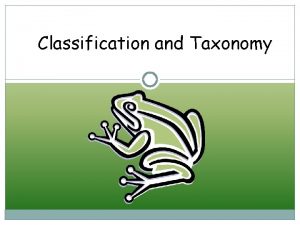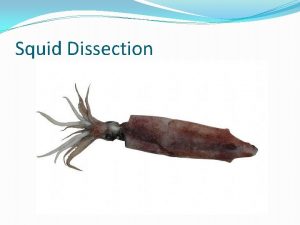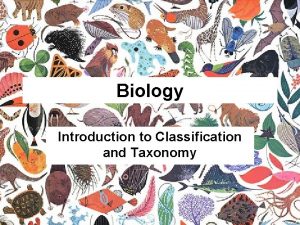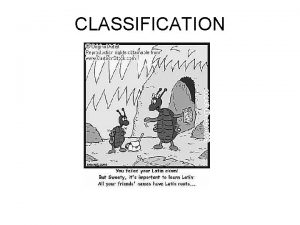Classification and Taxonomy WARMUP Can we still classify































- Slides: 31

Classification and Taxonomy

WARM-UP Can we still classify organisms based on physical appearances given what we know about DNA? Hint: Think analogous structures…

Basic Definitions Classification the grouping of objects or information based on similarities. Taxonomy the branch of Biology concerned with the grouping and naming of organisms.

Consider this… Biologists have identified and named approximately 1. 5 million species so far. They estimate that between 2 and 100 million species have yet to be identified.

Finding Order in Diversity 1. Why Classify? 2. Why give scientific names? jellyfish Go to Section: To organize and name organisms Common names are misleading silverfish star fish None of these animals are fish!

Why Scientists Assign Scientific Names to Organisms Some organisms have several common names This cat is commonly known as: • Florida panther • Mountain lion • Puma • Cougar Scientific name: Felis concolor Scientific name means “coat of one color” Go to Section:

Carolus Linnaeus By the 18 th century, scientists realized that naming organisms with common names was confusing. Swedish botanist. Developed a system for naming plants and animals called binomial nomenclature.

Why Latin? dead language Common Words among languages would not be confused Old Greek is also used for scientific naming Fun Fact: What do you think “ambulate” from Latin means? Hint: ambulance

Binomial Nomenclature Linnaeus gave each organism a 2 -part name. The first part is the Genus, second is the species. Together they form the Scientific name of organism.

7 Levels of Classification Kingdom broadest level Phylum Class Order Family Genus Species most specific

Levels of Classification -based on contributions of both Aristotle and Linnaeus There are 7 levels of classification. Remember the first letter of this sentence: King Philip Came Over For Good Spaghetti.


Example: Dog

Full Taxonomy Common Name: American Eskimo Dog - Toy Kingdom: Animalia Phylum: Chordata Class: Mammalia Order: Carnivore Family: Canidae Genus: Canis Species: familiaris

Rules for writing Scientific Names The first letter of the Genus name is always capitalized. The first letter of the species name is never capitalized. Scientific names are italicized (if typed) or underlined (if handwritten).

Which of these is written correctly? Viola tricolor (pansy with 3 -colored flower) Quercus phellos (Willow Oak) Nymphaea ordata (fragrant water lily) Clostridium Botulinum (bacteria that causes a form of food poisoning) homo sapiens

EXAMPLES… The house cat (Felis domesticus) and the mountain lion (Felis concolor).

Kingdoms The 6 kingdoms are: Archebacteria, Eubacteria, Protista, Fungi, Plantae, and Animalia.

Domains 3 Domains to classify Kingdoms Domain: Archaea --prokaryotic Domain: Bacteria –prokaryotic Domain: Eukarya --eukaryotic

Archaea Domain Kingdoms: Archeabacteria Prokaryotic: no nuclear membrane, Characterized: by living in extreme environments Example: Thermoacidophiles – thrive in acid and high temperatures (up to 110 degrees Celsius)

Bacteria Domain Kingdoms: Eubacteria Prokaryotic – no nuclear membrane Example: Cyanobacteria – photosynthesizing bacteria

Eukarya Domain Kingdoms: Plant, Animal, Fungi, Protists Eukaryotic: yes nuclear membrane~!

Cladogram A way to show (graph) evolutionary history of an organism is a Cladogram. Example: legs on a snake


Gradual Vs Punctuated Equilibrium

Gradual Vs Punctuated Equilibrium

Using the Classification System Field guides help identify organisms. -they highlight differences between similar organisms (like trees) Taxonomic Key (AKA Dichotomous Key) -paired statements that describe the physical characteristics (aka Phenotypic characteristics) of different organisms

Taxonomic Key 1. Fruits occur singly. . . . Go to 3 1' Fruits occur in clusters of two or more. . . Go to 2 2. Fruits are round. . . . Grapes 2' Fruits are elongate. . . . Bananas 3. Thick skin that separates easily from flesh. . . Oranges 3' Thin skin that adheres to flesh. . . . Go to 4 4. More than one seed per fruit. . . . Apples 4' One seed per fruit. . . Go to 5 5. Skin covered with velvety hairs. . . . . Peaches 5' Skin smooth, without hairs. . . . Plums

Linnaeus’s System of Hierarchy Least specific Kingdom 1. Phylum Class 2. Which of the following contains all of the others? a. Family c. Class b. Species d. Order Based on their names, you know that the baboons Papio annubis and Papio cynocephalus do not belong to the same: Family a. Family c. Order b. Genus d. Species Genus Most specific Species

Domain & Kingdom Relationships Plantae Animalia Archaebacteria Protista Fungi_____, Kingdom: ________ Kingdom: Eubacteria ______ Kingdoms: _______, _____ Archaea Domain ______ Bacteria Domain _____ First Cells Eukarya Domain ______

 Kendall and marzano
Kendall and marzano Warmup ratio
Warmup ratio Warmup 65
Warmup 65 Gmass warmup
Gmass warmup Status vs class
Status vs class Pyramid warmup
Pyramid warmup Warm rhyming words
Warm rhyming words Exponent multiplication
Exponent multiplication Java warmup
Java warmup Define:warmup
Define:warmup Pathos story
Pathos story Tom schwartz tinman
Tom schwartz tinman Warmup 65
Warmup 65 Warmup end
Warmup end Dichotomous classification
Dichotomous classification Dichotomous key of animals
Dichotomous key of animals What are the ways to classify vegetables
What are the ways to classify vegetables How to write scientific names
How to write scientific names Horse phylum
Horse phylum Squid kingdom
Squid kingdom Mushroom domain
Mushroom domain Color vectors and viewpoint in still and moving images
Color vectors and viewpoint in still and moving images Look at the pictures and complete with can or can't
Look at the pictures and complete with can or can't Manifold table in statistics
Manifold table in statistics How to draw dead nature
How to draw dead nature Picasso still life with guitar
Picasso still life with guitar Writer thinker maker textbook
Writer thinker maker textbook Be still and know that i am here
Be still and know that i am here What is text and still images
What is text and still images Compare and classify geometric shapes
Compare and classify geometric shapes How do you classify uniform and non-uniform mixtures?
How do you classify uniform and non-uniform mixtures? Pure substance examples
Pure substance examples























































